Tech-powered visual assessments are revolutionizing building inspections. You'll see drones equipped with high-resolution cameras and advanced sensors taking center stage, offering safer, faster, and more cost-effective alternatives to traditional methods. These aerial inspectors capture detailed imagery of hard-to-reach areas, allowing for thorough structural evaluations. AI-driven analysis processes vast amounts of visual data, quickly identifying potential issues. Smart sensors and IoT devices enhance real-time monitoring, while virtual and augmented reality tools are on the horizon. This tech integration not only improves safety and efficiency but also enables predictive maintenance, extending building life cycles. The future of building inspections is taking flight, and you're about to discover its full potential.
The Rise of Drone Inspections
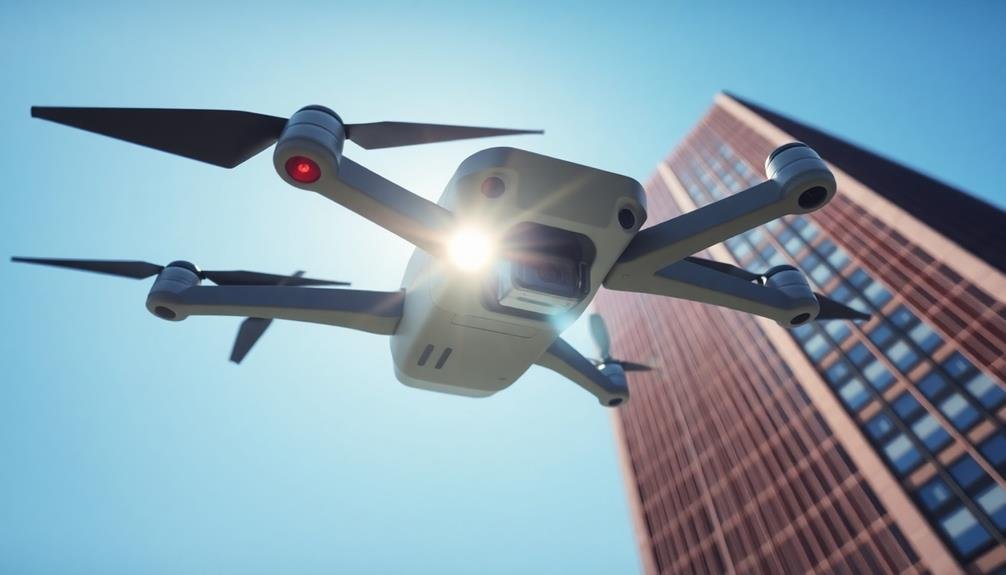
Drone technology has revolutionized visual inspections across industries. You'll find these unmanned aerial vehicles equipped with high-resolution cameras and sensors, capturing detailed imagery of buildings, infrastructure, and hard-to-reach areas. Drones offer a safer, faster, and more cost-effective alternative to traditional inspection methods.
When you use drones for building inspections, you're able to access areas that were once challenging or dangerous for human inspectors. They can easily navigate rooftops, facades, and other elevated structures, providing an all-encompassing view of the building's condition. You'll get real-time data and imagery, allowing for quick identification of issues like structural damage, leaks, or thermal inconsistencies.
The benefits extend beyond safety and efficiency. You'll save time and money by reducing the need for scaffolding or lifting equipment. Drones can cover large areas quickly, making them ideal for inspecting expansive properties or multiple buildings.
With advanced software, you can analyze the collected data to create detailed reports and 3D models. This technology empowers you to make informed decisions about maintenance, repairs, and renovations, ultimately enhancing building safety and longevity.
Benefits of Aerial Building Assessments
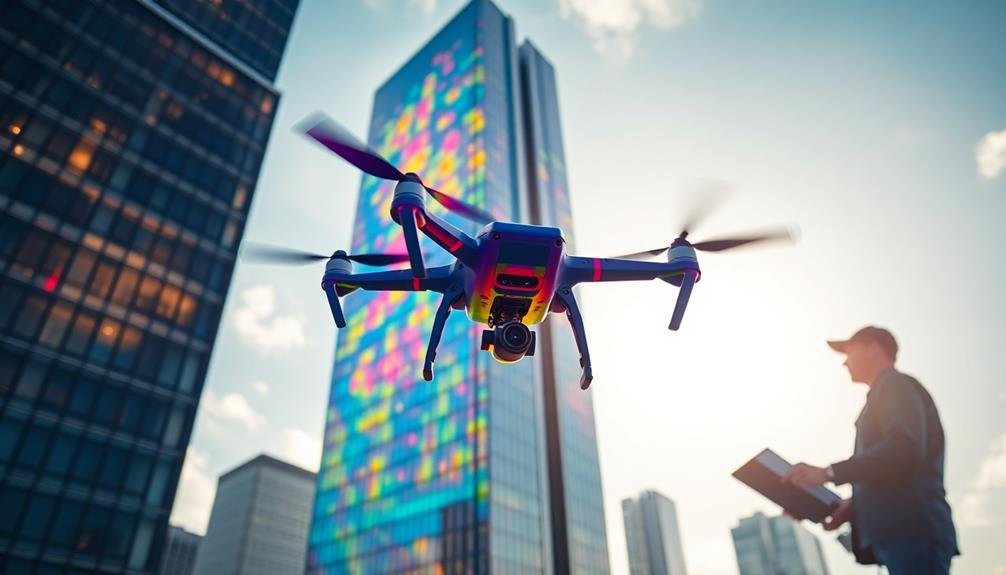
Aerial building assessments offer a range of advantages that go beyond the innovative use of drones. You'll find that these assessments provide an extensive view of a building's exterior, allowing you to spot issues that might be missed from ground level. They're particularly useful for examining hard-to-reach areas like rooftops, chimneys, and high-rise facades.
You can expect significant time and cost savings with aerial assessments. They're faster than traditional methods, reducing the need for scaffolding or cherry pickers. This efficiency translates to lower labor costs and minimized disruption to building occupants.
Safety is another key benefit, as inspectors don't need to physically access dangerous areas.
The high-resolution imagery captured during these assessments gives you detailed documentation of a building's condition. You'll have a visual record that's invaluable for planning maintenance, tracking deterioration over time, and providing evidence for insurance claims.
Additionally, thermal imaging capabilities can help you identify energy inefficiencies, moisture issues, and potential structural problems that aren't visible to the naked eye.
Cutting-Edge Drone Imaging Technologies
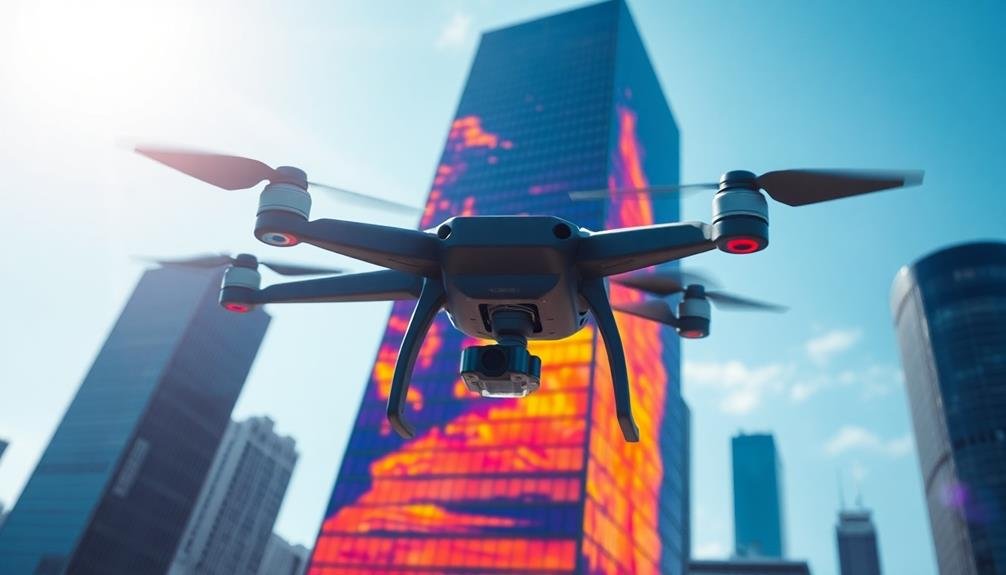
Cutting-edge imaging technologies have stepped up to revolutionize drone-based assessments. You'll find that modern drones are equipped with high-resolution cameras, capable of capturing detailed images and videos in 4K or even 8K quality. These advanced optics allow you to spot minute defects, cracks, or structural issues that might be invisible to the naked eye.
Thermal imaging cameras are another game-changer in drone technology. They enable you to detect heat signatures, revealing hidden moisture issues, insulation problems, or electrical hotspots in buildings.
LiDAR (Light Detection and Ranging) sensors on drones create precise 3D models of structures, giving you accurate measurements and spatial data.
Multispectral and hyperspectral imaging technologies have also entered the drone inspection arena. These tools capture data across multiple wavelengths, helping you identify material degradation, vegetation encroachment, or pollution effects on buildings.
Additionally, you'll benefit from real-time transmission capabilities, allowing instant analysis and decision-making during inspections. With AI-powered image processing software, you can automate defect detection and generate thorough reports, greatly reducing assessment time and improving accuracy.
Enhancing Safety in Building Inspections
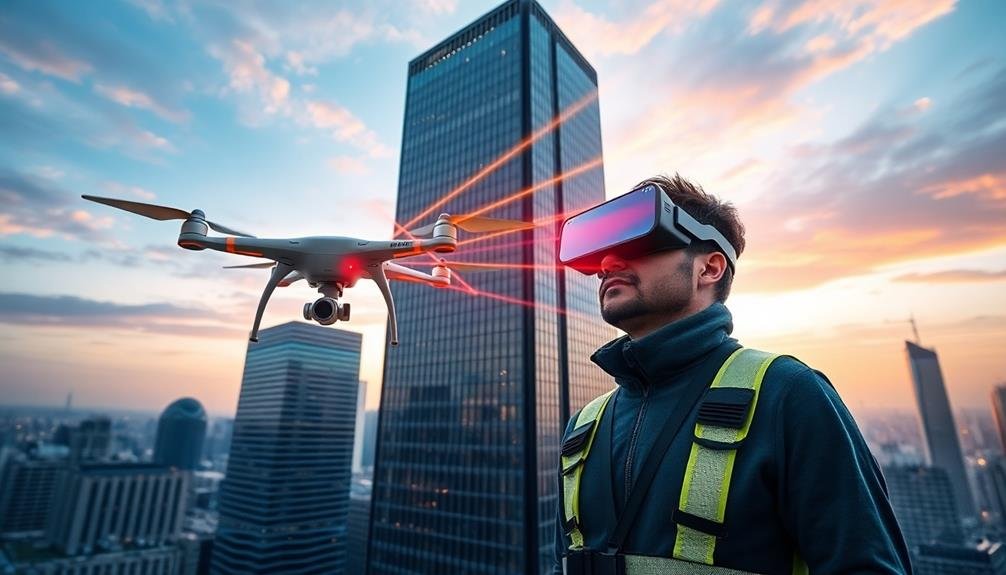
Safety in building inspections has taken a leap forward thanks to the integration of drone technology.
You'll find that drones have revolutionized the way inspections are conducted, greatly reducing risks associated with manual inspections. No longer do you need to scale tall structures or navigate hazardous areas to assess building conditions.
Drones equipped with high-resolution cameras and sensors can access hard-to-reach places, providing detailed imagery without putting human inspectors in harm's way.
You'll appreciate how this technology allows for more frequent inspections, catching potential issues before they become major problems.
Here's how drone technology enhances safety in building inspections:
- Eliminates the need for scaffolding or lifts, reducing fall risks
- Allows inspection of unstable structures without endangering personnel
- Provides real-time data, enabling quick response to urgent safety concerns
You'll notice that this approach not only improves safety but also increases efficiency.
Inspections that once took days can now be completed in hours, with more thorough results.
Data Processing for Visual Insights
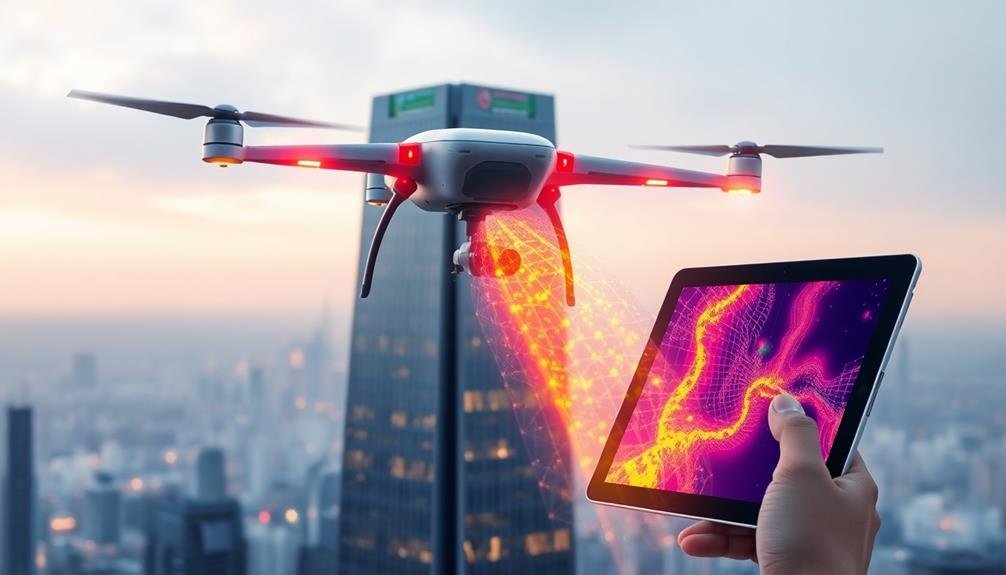
You'll find AI-driven image analysis revolutionizing how visual data is processed in tech-powered assessments.
Cloud-based data storage allows you to access and manage vast amounts of visual information from anywhere, enhancing collaboration and data security.
With real-time reporting systems, you're able to generate instant insights and make informed decisions based on the most up-to-date visual data available.
Ai-Driven Image Analysis
Machines are becoming increasingly adept at processing and interpreting visual data. AI-driven image analysis is revolutionizing building inspections by automating the detection of defects, anomalies, and potential issues. You'll find that this technology can analyze thousands of images in minutes, identifying patterns and problems that might escape the human eye.
AI algorithms can be trained to recognize specific features, such as cracks, corrosion, or structural irregularities. As you implement this technology, you'll notice improved accuracy and consistency in your inspections. The AI can categorize and prioritize issues, allowing you to focus on the most critical areas first.
Some key benefits of AI-driven image analysis include:
- Faster processing times, reducing inspection duration
- Objective and consistent assessments across multiple properties
- Early detection of potential problems, preventing costly repairs
You'll also appreciate the ability to track changes over time, as AI can compare current images with historical data to identify progressive deterioration.
This predictive capability enables you to plan maintenance more effectively and extend the lifespan of buildings. By leveraging AI-driven image analysis, you're not just improving the efficiency of your inspections; you're enhancing the overall quality and longevity of the structures you manage.
Cloud-Based Data Storage
As AI-driven image analysis generates vast amounts of data, robust storage solutions become necessary. Cloud-based data storage offers an ideal solution for managing the extensive visual information collected during building inspections. You'll find that this approach provides scalability, accessibility, and security for your inspection data.
With cloud storage, you can easily scale your data capacity as your inspection needs grow. You're not limited by physical hardware constraints, allowing you to store and process an ever-increasing volume of images and videos. This flexibility guarantees you'll always have enough space for your visual assessment data.
You'll appreciate the accessibility cloud storage provides. Your team can access inspection data from anywhere, at any time, using various devices. This feature facilitates collaboration and enables quick decision-making based on real-time information.
Security is paramount when dealing with sensitive building inspection data. Cloud storage providers offer robust encryption and multiple layers of protection, guaranteeing your data remains safe from unauthorized access or loss.
You'll benefit from regular backups and disaster recovery options, giving you peace of mind about your valuable inspection records.
Real-Time Reporting Systems
Once visual data is collected and stored, real-time reporting systems transform raw information into actionable insights.
These systems use advanced algorithms and machine learning to analyze images and videos, identifying potential issues and generating detailed reports in minutes. You'll receive instant notifications about critical findings, allowing you to address problems promptly and efficiently.
Real-time reporting systems offer numerous benefits for building inspections:
- Faster decision-making: You can access up-to-date information on your mobile device, enabling quick responses to urgent situations.
- Improved accuracy: AI-powered analysis reduces human error and provides consistent, objective assessments across multiple properties.
- Enhanced collaboration: Teams can share findings and collaborate remotely, streamlining the inspection process.
Integrating AI in Inspection Analysis
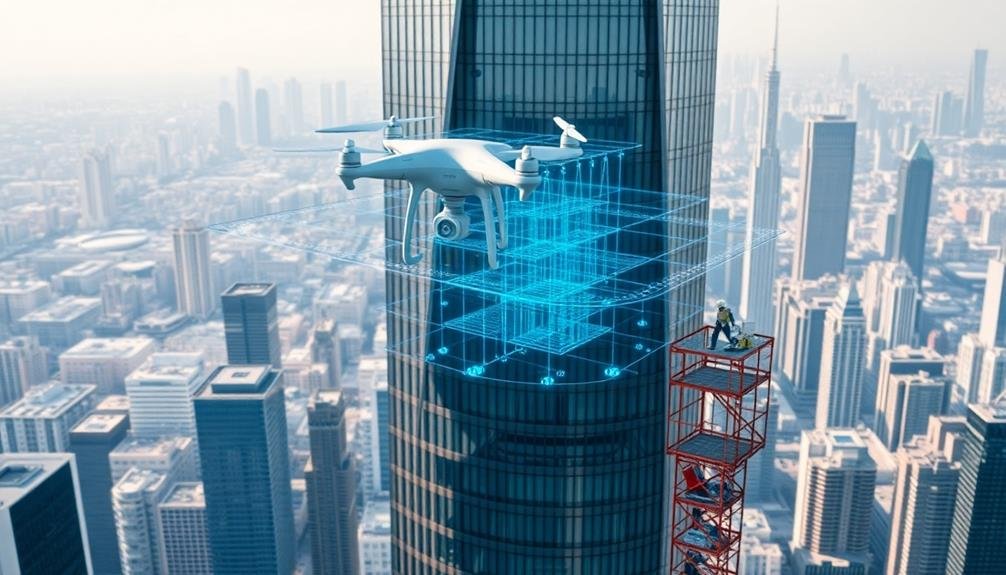
You'll find AI revolutionizing inspection analysis through advanced defect detection capabilities.
Machine learning algorithms can now recognize intricate patterns and anomalies that might escape human observers.
Ai-Powered Defect Detection
In light of rapid technological advancements, AI-powered defect detection has revolutionized inspection analysis across various industries. You'll find that this cutting-edge technology markedly improves accuracy and efficiency in identifying structural issues, material flaws, and safety hazards.
By leveraging machine learning algorithms and computer vision, AI systems can quickly process vast amounts of visual data, detecting even the smallest defects that might escape the human eye.
When implementing AI-powered defect detection in your inspection processes, you'll benefit from:
- Reduced human error and increased consistency in assessments
- Faster inspection times, allowing for more frequent checks
- Early detection of potential problems, preventing costly repairs
You'll notice that these AI systems can be trained to recognize specific defect patterns, adapting to various building types and materials. They can analyze images and video footage from drones, handheld devices, or fixed cameras, providing real-time insights and detailed reports.
As you integrate this technology into your workflow, you'll find that it complements human expertise rather than replacing it, allowing your inspectors to focus on complex decision-making and interpretation of AI-generated data.
Machine Learning Pattern Recognition
Machine learning pattern recognition forms the backbone of AI-integrated inspection analysis. This advanced technology enables you to identify complex patterns and anomalies in building structures that might escape the human eye. By training algorithms on vast datasets of building images, you can create models that accurately detect issues like cracks, corrosion, or structural deformations.
You'll find that machine learning excels at recognizing subtle changes over time, allowing for predictive maintenance and early intervention. It can analyze thousands of images in minutes, greatly speeding up the inspection process. The system learns and improves with each inspection, becoming more accurate and efficient.
To implement this technology, you'll need to collect high-quality data, choose appropriate algorithms, and fine-tune your models. You can integrate it with other inspection tools like drones or IoT sensors for extensive assessments.
Cost-Effectiveness of Drone-Powered Assessments
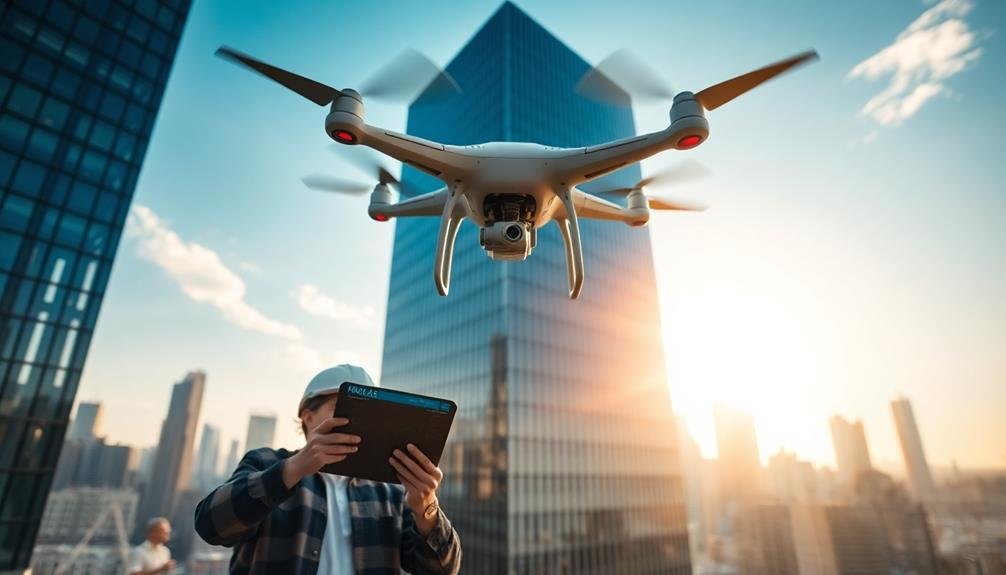
Drone-powered assessments frequently offer a cost-effective alternative to traditional visual inspection methods.
You'll find that drones can greatly reduce labor costs and time spent on inspections, especially for large or hard-to-reach structures. By using drones, you're able to gather high-quality visual data quickly and safely, without the need for expensive scaffolding or putting workers at risk.
When you compare the costs of drone inspections to traditional methods, you'll notice substantial savings in the long run.
Here are some key benefits:
- Reduced equipment costs: No need for lifts, scaffolding, or specialized climbing gear
- Decreased labor hours: Faster inspections mean fewer billable hours
- Minimized downtime: Less disruption to normal operations during assessments
You'll also find that drone technology allows for more frequent inspections, helping you catch potential issues early and avoid costly repairs down the line.
By investing in drone-powered assessments, you're not only saving money on the inspection process itself but also potentially preventing expensive damages that might go unnoticed with less thorough traditional methods.
As drone technology continues to advance, you can expect even greater cost savings and efficiency improvements in the future.
Regulatory Landscape for Drone Inspections
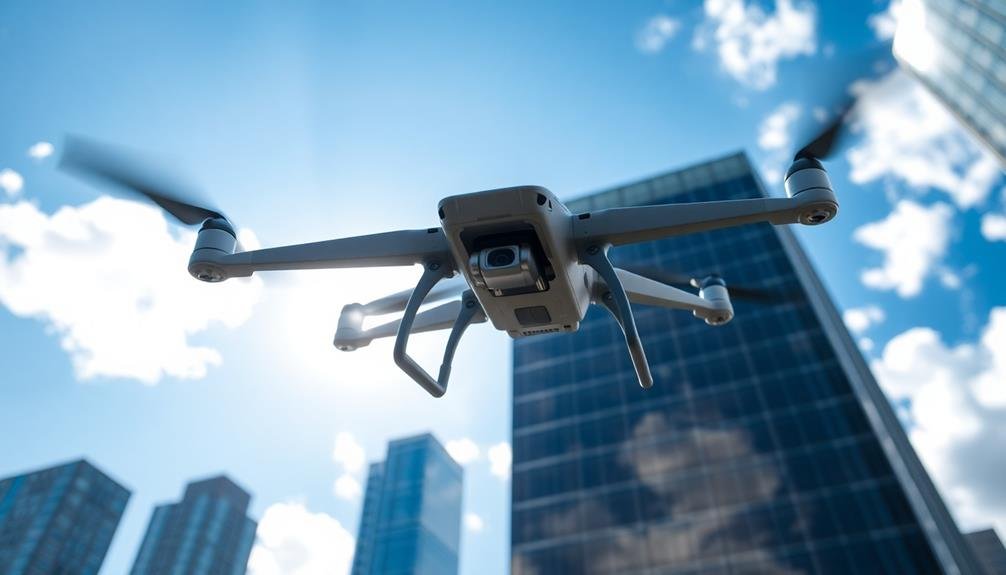
When thinking about drone inspections, you must navigate a complex regulatory landscape. The Federal Aviation Administration (FAA) oversees drone operations in the United States, and you'll need to comply with their rules.
First, register your drone and obtain a Remote Pilot Certificate if you're flying for commercial purposes.
You'll need to adhere to specific flight restrictions, including maintaining visual line of sight, flying below 400 feet, and avoiding restricted airspace. Be aware of local regulations, as some cities and states have additional drone laws.
For building inspections, you may need permission from property owners and nearby residents.
Privacy concerns are significant, so make certain you're not capturing images of private areas without consent. You'll also need to take into account insurance requirements, as standard business policies may not cover drone operations.
Stay updated on changing regulations, as drone laws evolve rapidly. Think about joining industry associations to stay informed and advocate for sensible regulations.
Future of Tech-Driven Building Evaluations
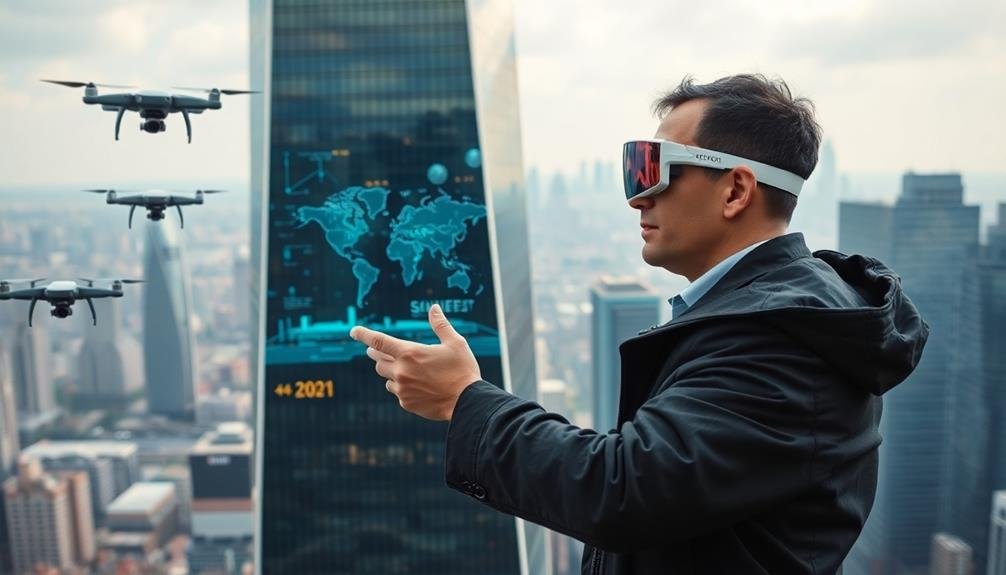
The future of tech-driven building evaluations looks incredibly promising. You'll see a convergence of cutting-edge technologies that will revolutionize how we assess and maintain structures.
Artificial intelligence and machine learning algorithms will analyze vast amounts of data collected from various sensors, drones, and IoT devices, providing real-time insights into a building's health and performance.
You can expect these advancements to transform the industry:
- Predictive maintenance systems that identify potential issues before they become critical
- Virtual and augmented reality tools for immersive, remote inspections
- Blockchain technology to guarantee data integrity and transparency in building records
As these technologies mature, you'll witness a shift towards more proactive and data-driven building management. Inspections will become faster, more accurate, and less disruptive to occupants.
You'll also see increased safety for inspectors as dangerous tasks are automated. Additionally, the integration of these technologies will lead to more sustainable buildings, as energy efficiency and environmental impact become easier to monitor and optimize.
Ultimately, tech-driven evaluations will enhance the longevity, safety, and performance of our built environment, making cities smarter and more resilient.
Frequently Asked Questions
How Long Does It Take to Train a Drone Operator for Building Inspections?
You'll typically need 2-4 weeks to train as a drone operator for building inspections. This includes learning FAA regulations, flight controls, safety protocols, and inspection techniques. Hands-on practice and certification exams are also part of the process.
Are There Any Building Types Unsuitable for Drone-Based Visual Assessments?
Yes, you'll find some buildings aren't suitable for drone inspections. These include structures near airports, military facilities, or in no-fly zones. Tall skyscrapers, buildings with complex interiors, or those in densely populated areas can also pose challenges.
What Weather Conditions Can Affect the Accuracy of Drone Inspection Results?
You'll find that strong winds, heavy rain, snow, and extreme temperatures can affect your drone's performance and image quality. Low light conditions may also impact visibility. It's best to conduct inspections in calm, clear weather.
How Often Should Drone-Based Inspections Be Conducted for Optimal Building Maintenance?
You should conduct drone-based inspections annually for routine maintenance. However, you'll need more frequent inspections after severe weather events or if you suspect structural issues. It's best to tailor your inspection schedule to your building's specific needs and conditions.
Can Drone Inspections Completely Replace Traditional Manual Building Assessment Methods?
While drone inspections can't completely replace manual methods, they're a powerful complement. You'll find they enhance efficiency and safety, but human expertise is still essential for detailed assessments and interpreting complex issues in building maintenance.
In Summary
You're witnessing a revolution in building inspections. Tech-powered visual assessments, especially drone-based solutions, are changing the game. They're safer, faster, and more cost-effective than traditional methods. As AI and advanced imaging technologies continue to evolve, you'll see even more accurate and insightful evaluations. Embrace this shift – it's not just about keeping up, it's about staying ahead. The future of building inspections is here, and it's tech-driven.

As educators and advocates for responsible drone use, we’re committed to sharing our knowledge and expertise with aspiring aerial photographers.




Leave a Reply